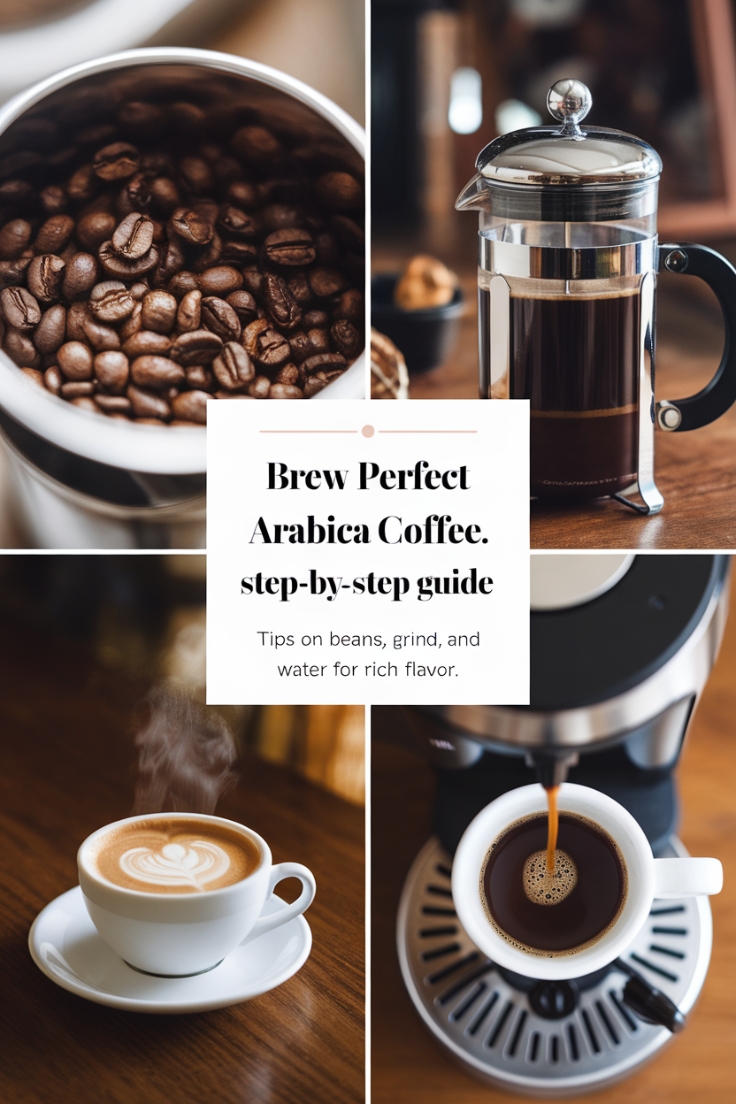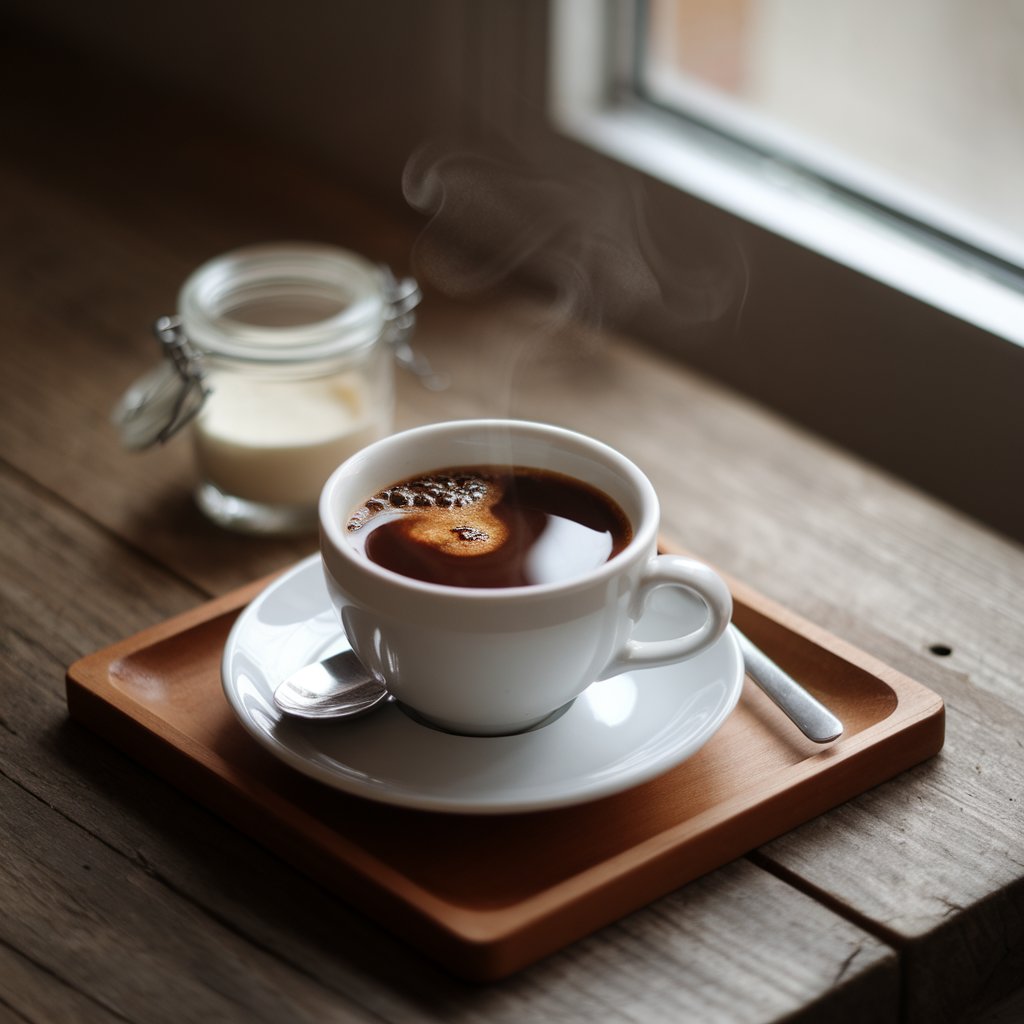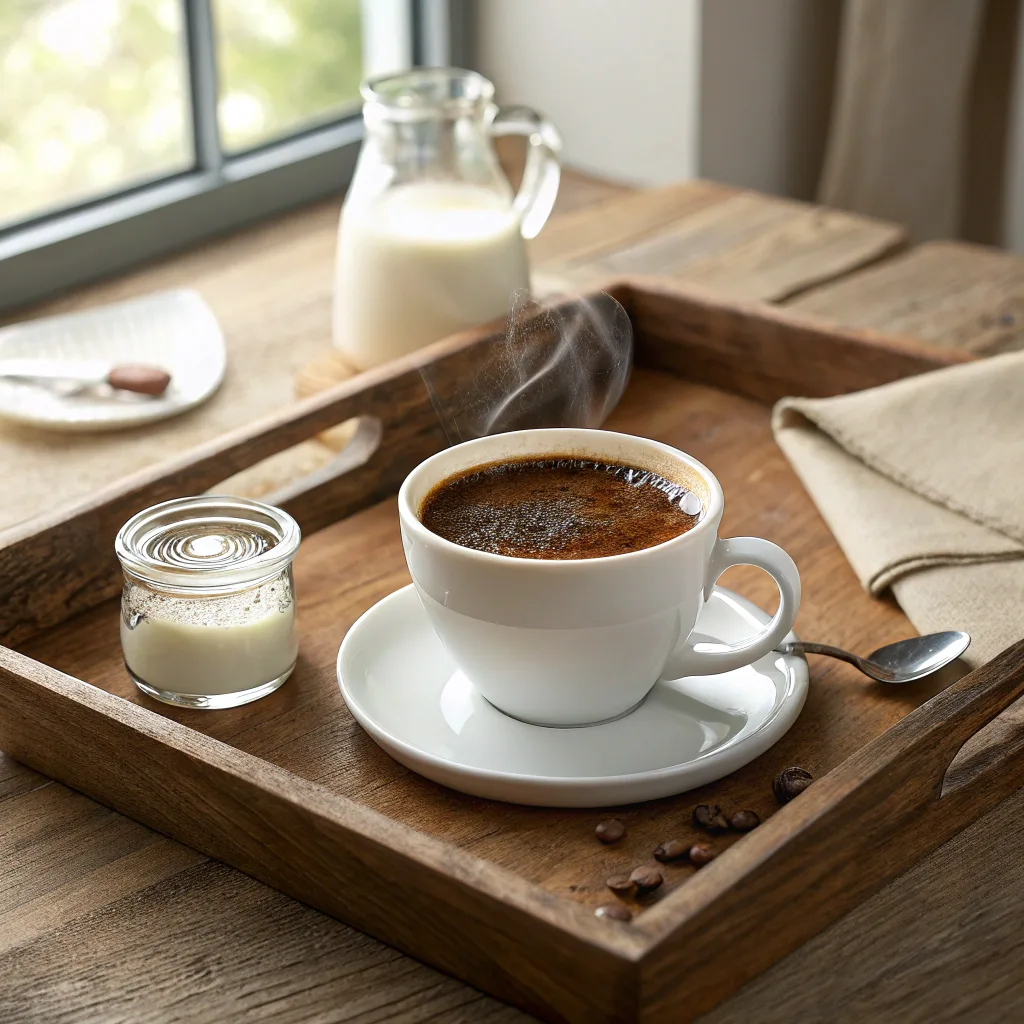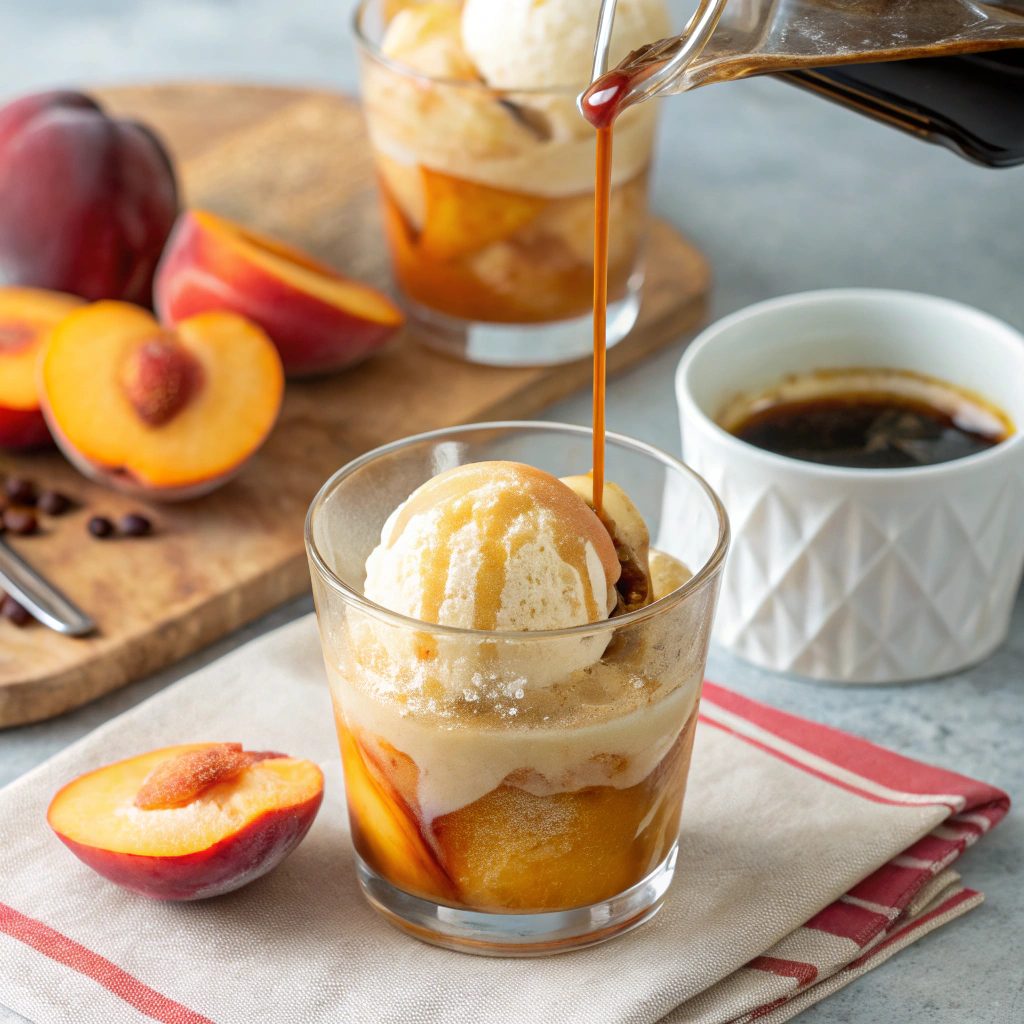Jump to Recipe
Brewing coffee at home creates a special magic. The amazing smell fills the air, warming your hands and soul. Each sip of this Arabica coffee recipe promises a rich flavor. It’s more than just a drink—it’s a unique journey. During my college days, a robust cup of Arabica coffee brightened up my days. Those comforting moments became a bond with my old drip machine.
Years later, motherhood brought earlier mornings. The steam whispers from my French press felt equally comforting. From a novice Starbucks barista to a homebrew expert, I’ve grown. I’m excited to show you how to make Arabica coffee that truly stands out, all from your kitchen.
We’ll explore the essentials of a genuine Arabica coffee recipe. Selecting the finest beans, perfecting the grind, and using the ideal water temperature are key. Choosing the right brewing method unlocks a treasure trove of flavour.
Let’s make your kitchen the best cafe around.
Skip the crowded bistros with their long lines. In our homes, we become expert baristas. Let’s craft an Arabic masterpiece that delights both the heart and palate. With the right elements, instructions, and patience, your coffee will be full of passion.
Key Takeaways
- Choose high-quality beans for a truly authentic Arabica coffee recipe.
- Use the correct water-to-coffee ratios—1 to 2 tablespoons per 6 ounces of water for full flavour.
- Prevent bitterness or weakness by avoiding over-extraction or under-extraction, respectively.
- Control the water temperature between 195 and 205 degrees Fahrenheit for optimal brewing.
- Adjust contact time—5 minutes for the drip, 2-4 minutes for French Press, 20–30 seconds for espresso, and 7–10 minutes for Turkish coffee.
- Consider a dark roast for traditional Turkish coffee and adjust sugar levels to taste, from “less sweet” to “extra sweet.”

Identifying Fresh Arabica Beans
Fresh beans mean a better brew. Look for the roast date on the bag, especially from small batch roasters. This shows how fresh the beans are. Aim to use beans roasted within the last week or two.
Choosing Between Light, Medium, and Dark Roasts
At Trader Joe’s, I decide on the roast that matches my mood for the week. If I want a milder taste, I pick light roasts. For a strong flavour, I go for dark roasts. The bean’s oiliness, especially in dark roasts, shows freshness. Using the beans within a week of opening enhances your coffee’s aroma and taste.
Start your coffee adventure by picking fresh arabica beans and the right roast. It’s the key to the best Arabica coffee you can make at home!
Mastering the Grind for Perfect Arabica Coffee
When starting the quest for the perfect Arabica coffee drink recipe, the grind is key. As a beginner in coffee making, I’ve learned the grind size is critical. It’s essential for turning beans into a delicious brew, whether it’s for strong espresso or rich French press.
If you love a good morning coffee ritual, getting the grind right is like making art.
A medium grind is just right for drip coffee, giving it a smooth taste. For espresso, a fine grind helps get that strong flavour quickly.
So, having a good grinder is a must for making great coffee.
For my Arabica coffee preparation guide, I live by “fresh is best.” Grinding beans right before brewing keeps the coffee’s smell and taste alive. My tip? Get a quality grinder. It’s your first step towards a cup of coffee that brings out the bean’s true flavour.
| Brewing Parameter | Details | Personal Tip |
|---|---|---|
| Coffee-to-Water Ratio | 1-2 tablespoons per 6 ounces | Adjust the ratio to taste; the golden ratio is a guide, not a dictator. |
| Water Temperature | 195°F to 205°F recommended | Use a kitchen thermometer to nail this crucial variable. |
| Brewing Time | Varies by method | For drip systems, aim for the 5-minute sweet spot. |
| Grind Size | Medium for drip, fine for espresso | Beyond freshness, precision in grind size can make or break your brew. |
| Freshness | Use within two weeks of roasting | Store beans in an airtight container to maintain peak flavor. |
| Bean Types | Arabica, Robusta, or a blend | Try blending Arabica and Robusta for a caffeine boost with balanced flavor. |
| Equipment Cleaning | Clean after each use | A clean machine is the unsung hero of a perfect cup. |
Optimal Water Quality and Temperature for Brewing
The quality and temperature of the water are key to brewing Arabica coffee. Water is the unseen hero in coffee, boosting or ruining the flavor.
The Impact of Water Quality on Coffee Flavor
For the best brew, use pure water—think filtered or bottled. I’ve tested different waters and found the best brews in those with balanced minerals. The Specialty Coffee Association (SCA) suggests water for cupping should have 125–175 ppm of total dissolved solids.

Temperature Precision: Finding the Sweet Spot
The right temperature range, 195 to 205 degrees Fahrenheit, is crucial for extracting the best flavor. Too hot, and you burn the coffee; too cold, and it doesn’t extract well. I target around 202-206 degrees for my arabica, a bit under-boiling, to unlock the best flavors.
Below is a table I made from loads of homebrew tests, aligning with the SCA’s Golden Cup standard:
| Brewing Method | Contact Time | Ideal Water Temperature (Fahrenheit) |
|---|---|---|
| Drip System | ~5 minutes | 195-205 |
| French Press | 2-4 minutes | 195-205 |
| Espresso | 20-30 seconds | 195-205 |
| Cold Brew | ~12 hours (overnight) | Cold water |
Always start with the right ingredients for brewing. A good coffee-to-water ratio is 8.25 grams per 150 ml. Follow these tips, and you’ll enjoy a cup as good as any from a fancy coffee shop. Plus, you made it yourself!
The Arabica Coffee Recipe: My Technique
Making the perfect arabica coffee blend is a mix of art and science. I have refined my arabica coffee recipe after many years. Paying close attention to the small details has been key.
Here are some tips and instructions to improve your coffee at home.
Proportions and Measurements for Full Flavor
I follow the “Golden Ratio,” which is one to two tablespoons of ground coffee for every six ounces of water.
This ensures your coffee is rich and full of flavor. It’s important to find what tastes best to you. Feel free to adjust it.
Brewing Time and Techniques to Enhance Aroma
When using a drip system, I brew for about 5 minutes. This is with water temperatures between 195 and 205 degrees Fahrenheit. This temperature range is best for extracting flavours.
For a French press or espresso, you might need to change the brewing time. Serve the coffee at 140 degrees Fahrenheit for the best warmth and taste.
From Grinder to Cup: The Journey of Arabica Coffee
Arabica beans are at the heart of the world’s favourite coffees. They have a richer, more complex flavour than robusta beans. This is why specialty coffee shops prefer them.
The journey begins with selecting the finest Arabica beans, the top 2%. Grinding them right before brewing captures their unique taste. The best flavor comes from beans ground 15 minutes before brewing, after roasting for 10 days to 2 weeks.
Roasting Arabica beans is an art. Small-batch roasters, handling 25 pounds or less, ensure freshness and quality. This attention to detail is crucial for an authentic Arabica coffee recipe.

Homemade Arabica Coffee
Ingredients
Method
- Select Fresh Beans: Use freshly roasted Arabica beans for the best flavor. Aim for beans roasted within the last 1-2 weeks.
- Grind the Beans: Use a medium grind size for drip coffee or a fine grind for espresso. Grind just before brewing to preserve freshness.
- Heat the Water: Heat filtered water to 195-205°F. Avoid boiling water as it can scorch the coffee.
- Measure Ingredients: Use 1-2 tablespoons of ground coffee per 6 ounces of water. Adjust to your taste preference.
- Brew: Use your preferred brewing method:
- For drip coffee, let it brew for about 5 minutes.
- For a French press, steep the coffee for 2-4 minutes.
- For espresso, brew for 20-30 seconds.
- Serve: Pour the freshly brewed coffee into your favorite cup. Add sugar, milk, or cream if desired.
- Enjoy: Sip and savor the rich, aromatic flavor of your homemade Arabica coffee.
Notes
- Use a kitchen thermometer to ensure accurate water temperature.
- Store your beans in an airtight container to maintain freshness.
- Experiment with different roast levels (light, medium, dark) to find your preferred flavor.
- Clean your brewing equipment after each use for the best results.
If Coffee is a journey, then Arabica is the destination worth savoring—delicate, high-grown, and distinctly flavorful.
Opt for high-grown Arabica beans for a transcendent taste experience, especially those nurtured at elevations of 3000 feet or above.
Integrate freshly ground Arabica beans into your preparation process, ideally within minutes of brewing, to preserve their pristine condition.
The peak moment of coffee enjoyment is when it reaches your cup. Drink it quickly. After grinding, coffee quickly loses its flavor.
Your authentic arabica coffee recipe should be enjoyed at its freshest.
| Bean Type | Common Usage | Quality Perception | Recommended Roasters |
|---|---|---|---|
| Arabica | Specialty coffee shops | Higher quality and wide flavor profiles | Small-batch (25 lbs or less) |
| Robusta | Grocery store coffee | Commercial-grade, less refined taste | Large-scale roasters |
Customizing Your Arabica Brew with Blend Ideas
Exploring the world of Arabica coffee opens up new aromatic experiences. Each bean tells its own story. Whether you prefer single varieties or mixed blends, you can make your coffee special.
I started with single-origin coffee, enjoying the unique tastes from around the world.
Experimenting with Single-Origin vs. Blended Beans
Single-origin beans are unique, each with its own flavor. For example, Ethiopian beans may have floral tastes, and Colombian beans could have nutty flavors. Blending beans is like mixing songs into a symphony. It combines flavours for a more complex taste.
The Art of Flavor Notes: Blending for Balance
Finding the perfect blend is about balance. You might mix a chocolatey bean with an acidic one for contrast. The key is to blend without letting one flavour dominate. Keep experimenting with different Arabica coffee blends to find your favourite taste. It could be a bold, dark roast or a light citrus one.
How Can My Home Brew Tips Enhance the Coffee Experience from Local Shops Outside Denver?
Home brew tips can elevate your coffee experience by allowing you to explore the unique flavors of local coffee gems. By experimenting with different brewing methods and adjusting grind sizes, you’ll uncover new taste profiles that complement the offerings from shops outside Denver, making each cup an adventure.
Conclusion
Brewing Arabica coffee at home transcends simple drink preparation—it’s a journey into the art and science of coffee. Each step, from selecting beans to perfecting the brew, enhances your experience, making each cup a reflection of global cultures and rich traditions.
As you refine your technique, remember that your dedication to quality brings the world’s most beloved beverage into your kitchen.
Embrace each cup as more than just coffee; see it as a connection to the global tapestry of coffee lovers and a celebration of the nuanced flavors of Arabica beans.
FAQ
What ingredients do I need for a homemade arabica coffee recipe?
You’ll need fresh whole arabica beans, clean filtered water, and maybe sugar, milk, or syrups to taste.
How do I make authentic Arabic coffee?
Use quality arabica beans and grind them fresh. Make sure to use filtered water at the ideal temperature. Also, get the ratio of coffee to water right, depending on your brewing gear.
How do I identify fresh Arabica beans?
Check for a recent roast date. Fresh beans smell strong and dark roasts look shiny because of the oil.
Should I choose light, medium, or dark roasts?
It’s all about your taste. Light roasts are milder and more acidic. Medium roasts are balanced. Dark roasts pack a bold flavor.
What’s the best grind consistency for Arabica coffee?
Match the grind to your brewing style: coarse for French press, medium for drip, and fine for espresso.
Why is water quality important for brewing coffee?
Clean, filtered water is key. Impurities can ruin your coffee’s taste.
What is the ideal water temperature for brewing Arabica coffee?
For arabica, heat water just under boiling, around 195°F to 205°F. This keeps your coffee from burning.
What are the proper proportions and measurements for full-flavored Arabica coffee?
Start with 2 tablespoons of coffee per 6 ounces of water. Adjust to suit your taste.
How long should I brew my Arabica coffee to enhance the aroma?
Brew time depends on the method. Try 4 minutes for the French press, 2 for espresso, and 5 for drip to get great flavor and smell.
How can I ensure the best flavor when brewing Arabica coffee?
Brew with fresh grounds, keep your gear clean, and stick to the guidelines for your brewing method.
Should I try single-origin or blended beans for my Arabica coffee?
It’s a matter of preference. Single-origin shows off specific tastes, while blends can offer a well-rounded profile.
How can I blend beans to achieve a balanced flavor?
Aim for a mix of acidic, sweet, and bitter. Try combining beans of various origins or roast levels.



